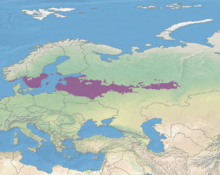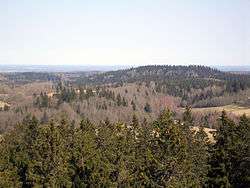Sarmatic mixed forests

Ecoregion PA0436
The Sarmatic mixed forests constitute an ecoregion within the Temperate broadleaf and mixed forests Biome, according to the World Wide Fund for Nature classification (ecoregion PA0436).
Distribution
This ecoregion is situated in Europe between boreal forests/taiga in the north and the broadleaf belt in the south and occupies about 846,100 km² (326,700 mi²) in southernmost Norway, southern Sweden, southwesternmost Finland, northern Lithuania, Latvia, Estonia, northern Belarus and the central part of European Russia.
It is bordered by the ecoregions of Scandinavian and Russian taiga (north), Urals montane tundra and taiga (east), East European forest steppe (southeast), Central European mixed forests (southwest) and Baltic mixed forests (west), as well as by the Baltic Sea.
Description
The ecoregion consists of mixed forests dominated by Quercus robur (which only occasionally occurs farther north), Picea abies (which disappears further south due to insufficient moisture) and Pinus sylvestris (in drier locations). Geobotanically, it is divided between the Central European and Eastern European floristic provinces of the Circumboreal Region of the Holarctic Kingdom.
-
Stockholm - Swamp in a sarmatic mixed forest.
-
-
-
| Palearctic temperate broadleaf and mixed forests |
| Apennine deciduous montane forests |
Italy |
| Atlantic mixed forests |
Denmark, France, Belgium, Germany, Netherlands |
| Azores temperate mixed forests |
Portugal |
| Balkan mixed forests |
Bulgaria, Greece, Macedonia, Romania, Serbia, Turkey |
| Baltic mixed forests |
Sweden, Denmark, Germany, Poland |
| Cantabrian mixed forests |
Spain, Portugal |
| Caspian Hyrcanian mixed forests |
Iran, Azerbaijan |
| Caucasus mixed forests |
Georgia, Armenia, Azerbaijan, Russia, Turkey |
| Celtic broadleaf forests |
United Kingdom, Ireland |
| Central Anatolian deciduous forests |
Turkey |
| Central China loess plateau mixed forests |
China |
| Central European mixed forests |
Austria, Germany, Lithuania, Moldova, Poland, Belarus, Czech Republic |
| Central Korean deciduous forests |
North Korea, South Korea |
| Changbai Mountains mixed forests |
China, North Korea |
| Changjiang Plain evergreen forests |
China |
| Crimean Submediterranean forest complex |
Russia, Ukraine |
| Daba Mountains evergreen forests |
China |
| Dinaric Mountains mixed forests |
Albania, Bosnia and Herzegovina, Italy, Montenegro, Serbia, Slovenia, Croatia |
| East European forest steppe |
Bulgaria, Moldova, Romania, Russia, Ukraine |
| Eastern Anatolian deciduous forests |
Turkey |
| English Lowlands beech forests |
United Kingdom |
| Euxine-Colchic deciduous forests |
Bulgaria, Georgia, Turkey |
| Hokkaido deciduous forests |
Japan |
| Huang He Plain mixed forests |
China |
| Madeira evergreen forests |
Portugal |
| Manchurian mixed forests |
China, North Korea, Russia, South Korea |
| Nihonkai evergreen forests |
Japan |
| Nihonkai montane deciduous forests |
Japan |
| North Atlantic moist mixed forests |
Ireland, United Kingdom |
| Northeast China Plain deciduous forests |
China |
| Pannonian mixed forests |
Austria, Bosnia and Herzegovina, Czech Republic, Hungary, Romania, Serbia, Slovakia, Slovenia, Ukraine, Croatia |
| Po Basin mixed forests |
Italy |
| Pyrenees conifer and mixed forests |
France, Spain, Andorra |
| Qin Ling Mountains deciduous forests |
China |
| Rodope montane mixed forests |
Bulgaria, Greece, Macedonia, Serbia |
| Sarmatic mixed forests |
Russia, Sweden, Norway, Denmark, Finland, Lithuania, Latvia, Estonia, Belarus |
| Sichuan Basin evergreen broadleaf forests |
China |
| South Sakhalin-Kurile mixed forests |
Russia |
| Southern Korea evergreen forests |
South Korea |
| Taiheiyo evergreen forests |
Japan |
| Taiheiyo montane deciduous forests |
Japan |
| Tarim Basin deciduous forests and steppe |
China |
| Ussuri broadleaf and mixed forests |
Russia |
| West Siberian broadleaf and mixed forests |
Russia |
| Western European broadleaf forests |
Switzerland, Austria, France, Germany, Czech Republic |
| Zagros Mountains forest steppe |
Iran, Arabian Peninsula |
References



